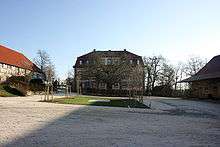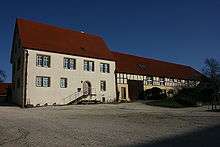Ludwigsruhe
Ludwigsruhe is a hamlet in Hohenlohe. It is a suburb of the town of Langenburg in the district of Schwäbisch Hall, located in Baden-Württemberg, Germany. Until 11 August 1761, the place was called Lindenbronn. Prince Louis of Hohenlohe-Langenburg then changed the name of the hamlet to match the name of the lustschloss he had built there.


History
The hamlet of Lindenbronn was acquired by the Hohenlohe-Langenburg family in 1556. In the years that followed, they created a 28-acre park to hunt. In 1750, the park was surrounded by a wall.
In 1736, Prince Louis began building a summer residence in the park. It was designed by Leopoldo Retti, and Retti's original design was based on early 18th century Parisian city architecture. Prince Louis only built a simplified version of the original design.
On the ground floor were some utility rooms, a garden room and a dining room. The first floor contained a large hall and three residential apartments. This is typical for a lustschloss, a type of château which was also invented in France. In the façade of the Ludwigsruhe château, we see a mix of architecture from the court at Ansbach, windows arranged like the palace in Ludwigsburg and "eared" window frames of unknown origin.[1] Construction of the château was completed in 1743.
In the 19th century, a dairy farm was attached to the manor.[2] The park and the château have been privately owned since 1980, and they can be rented for events.
References
- Schloß Ludwigsruhe, in: Walther-Gerd Fleck: Burgen und Schlösser in Nordwürttemberg, Weidlich, Frankfurt am Main, 1979, ISBN 3-8035-1014-7, p. 275–278
- Klaus Merten: Die Schlösser der Grafen und Fürsten von Hohenlohe im 18. Jahrhundert, in: Harald Siebenmorgen (ed.): Hofkunst in Hohenlohe, Sigmaringen, 1996, p. 23–38
- Gerhard Taddey: Hofkunst in Hohenlohe – das historische Umfeld, in: Harald Siebenmorgen (ed.): Hofkunst in Hohenlohe, Sigmaringen, 1996, p. 19–22
- Rolf Bidlingmaier (1997), "Die Brüder Riccardo, Paolo, Livio und Leopoldo Retti. Eine oberitalienische Künstlerfamilie im Herzogtum Württemberg", Südwestdeutsche Blätter für Familien- und Wappenkunde, Stuttgart: Verein für Familien- und Wappenkunde in Württemberg und Baden, 21 (13): 569–584, ISSN 0172-1844
External links
Footnotes
- leopoldo-retty.de: Bauten außerhalb des herrschaftlichen Bauwesens
- F. Ludwig: Neuestes Conversations-lexicon; oder, allgemeine deutsche Real-encyclopaedie fuer gebildete Staende, Vienna, 1830
